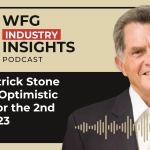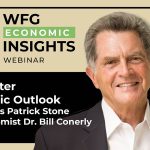

Some industry analysts are pessimistic about the outlook for the housing market; others are uncertain. Pat Stone, President and CEO of Williston Financial Group (WFG National Title’s parent company) is confident and emphatically upbeat. Speaking to title agents a few weeks ago at the Executive Management conference hosted by WFG’s Southwest Region, Pat described a perfect storm of positive indicators favoring the economy generally and housing in particular. The main items on his list:
- Baby boomers are no longer the largest age group; it is 22-year-olds who now hold that title. There will be more than 4.6 million heads of household in their prime household formation years (between the ages of 26 and 36) by the year 2020, Pat noted, and that growth, he said, will fuel “another real estate boom. That makes me very optimistic about the outlook.”
- Household formation rates. Pessimists cite the decline in new households as a major current and future drag on home sales. But differences in the way this statistic is calculated can produce wildly different results, Pat observed, making housing construction data, in his view, a much more reliable indicator. And the trend here is encouraging. Between 2000 and 2006, Pat noted, builders constructed 2.3 million more homes than were needed to meet demand. Given that mismatch, “Are we surprised prices went down?” Over the past six years, household formation rates have increased and more than 100,000 units have become obsolete annually, reducing the housing vacancy rate to 1.83 percent in the third quarter of this year. That’s compared to a high of 2.8 percent four years ago and close to the “equilibrium” vacancy rate of approximately 1.7 percent, at which new construction will make sense again. “We still have a little way to go,” Pat acknowledged, but within the next year, he predicts, single family construction activity will begin to pick up and multi-family y construction, which has been soaring on strong demand for rental housing, will slow.
- Interest rates. Mortgage rates are linked closely to the 10-year bond rate. In a “normal” market, without the subsidy provided by Federal Reserve policies aimed at bolstering the housing, Pat noted, 30-year mortgage rates (the 10-year bond rate plus the inflation rate) would be higher than they are currently, but not that much higher – around 5.5 percent. “Do you think we could live with that?” he asked. He doesn’t share the fear expressed by some analysts that the Fed’s policies will push inflation and interest rates damagingly higher. “I will retire before inflation becomes a problem and before mortgage rates exceed 6.5 percent. It isn’t going to happen,” he insisted.
- First-time buyers. First-time buyers have been largely unrepresented in the housing market recovery to date, leading some analysts to suggest that this may be a long-term trend, reflecting a declining interest in home ownership. Pat disagrees. Polls show consistently “no difference in attitudes” toward homeownership, he noted. It’s not a lack of belief in the American Dream, but lack of confidence in their ability to pursue it that has kept first-time buyer son the sidelines, he believes. As confidence levels rise, he predicts, first-time buyers will return to the housing market.
- Consumer confidence. Distinguishing consumer confidence (which measures near-term views) from consumer sentiment (reflecting long-term expectations), Pat noted that between 2008 and 2009, “confidence crashed,” falling more than 35 points below consumer sentiment. Now, the two measures are “more closely aligned,” he said. When confidence exceeds sentiment, “that’s when people start spending money” – on housing, among other goods.
- The economy. The positive indicators Pat sees here include:
- Government spending and investment in residential construction, both missing during much of the recovery, are increasing, spurring more rapid economic growth. Gross Domestic Product, though still “way below the historical average” for recoveries, “is moving in the right direction.”
- The employment picture is also brightening. The key indicator to watch, Pat suggests, is not the unemployment rate but the trend, which “has been fairly good. It’s moving in the right direction, albeit slowly.” And continued employment growth will bolster consumer confidence and boost demand for housing.
Looking at the differing housing forecasts for next year, Pat noted that the Mortgage Bankers Association tends to be unduly pessimistic, while the National Association of Realtors is at the opposite extreme. “We need to be somewhere in between,” he suggested.
His prediction: The economy will grow by at least 3.5 percent annually over the next five quarters; consumer confidence will blow past the 95 mark (it hit 95.4 in October – its highest level in7 years); first-time buyers will return to the market in force, and as they do, home sales will increase from a slow walk to “a sprint”; the housing market will “normalize” and will be “much better” next year. By 2016, Pat predicts, “we’ll be talking about something else.”
The post Pat Stone Looks Ahead at the Housing Indicators — and Likes What He Sees appeared first on WFG National Title Insurance Company.




